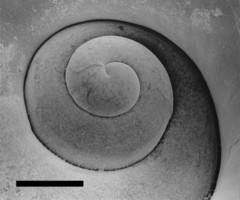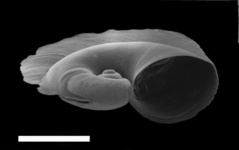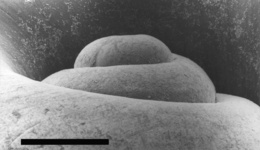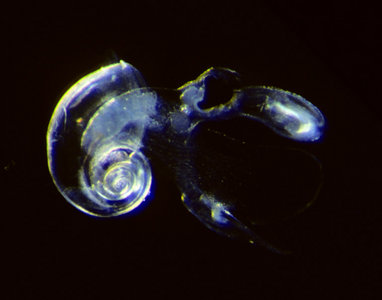Atlanta lesueurii
Atlanta lesueuri
Roger R. SeapyIntroduction
The maximal shell size of Atlanta lesueurii appears to vary geographically; from 2 mm in Hawaiian and eastern Australian waters to 6 mm in the tropical western Pacific. The shell is transparent, thin and fragile, with a smooth surface (lacking raised sculpture). The spire is very small, somewhat elevated and compact, consisting of about 2-1/2 whorls. Spire sutures are deep, with the result that the whorls are somewhat rounded in profile and can easily be distinguished. After metamorphosis the outermost whorl enlarges and inflates rapidly and the keel becomes progressively taller, becoming very tall in large adults and having a truncate leading edge. The keel base and spire sutures are colorless. Eyes type b, with a large lens. Operculum type b. Radula type I, with a narrowly triangular shape; largest in the genus Atlanta. Geographic distribution is cosmopolitan in tropical to subtropical waters.Diagnosis
- Maximal shell size appears to vary geographically from 2 to 6 mm
- Shell transparent with a thin, fragile walls
- Shell surface smooth; lacking surface sculpture
- Spire compact, comprised of about 2-1/2 whorls
- Spire sutures incised, enabling distinction of whorls
- Keel tall, with a truncate leading edge
- Eyes type b; lens large
- Operculum type b
- Radula type I, narrowly triangular shape
Characteristics
- Shell
- Maximal shell size appears to vary geographically, from 6 mm in the western tropical Pacific (Souleyet, 1852), 4 mm in the North Atlantic and Indian Oceans (Richter, 1986, 1974, respectively), and 2 mm off Hawaii (Seapy, 1990a,b) and eastern Australia (Newman, 1990)
- Shell and keel transparent with thin walls
- Shell surface smooth, lacking raised sculpture on the spire
- Spire very small, compact and somewhat elevated, consisting of about 2-1/2 whorls; spire whorls somewhat rounded and distinct from each other due to deep sutures (see fourth SEM below)
- Keel tall, with a truncate leading edge (see first SEM below)
 Click on an image to view larger version & data in a new window
Click on an image to view larger version & data in a new window



Figure. Scanning electron micrographs of a 1.2 mm Atlanta lesueurii, viewed from the right side (above left), the shell spire (above right), the right side (below left) and spire (below right) tilted about 60°. Scale bars = 0.5 mm (left) and 0.1 mm (right). ©
- Body coloration lacking in juveniles (see second title illustration), but with growth the spire tissues become pink (see first title illustration) to pinkish-violet (see photograph below)
- Eyes type b, with a large lens (see first title illustration)
- Operculum type b; thin
- Radula type I; largest in the genus Atlanta (Richter, 1961)
- Shape triangular
- Lateral teeth monocuspid
- Number of tooth rows can exceed 100 in older adults (Richter and Seapy, 1999)
Comments
Atlanta lesueurii has been recorded in high abundances from the northwestern Indian Ocean (Richter, 1974) and Hawaiian waters in the North Pacific (Seapy, 1990a,b and 2008). In Richter's study it ranked second of 15 species, representing 9.8% of the total species count. In Hawaiian waters it ranked highest of thirteen species, with 27% of the total species count (Seapy, 1990a). In a diel vertical distribution study (Seapy, 1990b), it was the most abundant of thirteen species, with maximal mean densities of 27 and 37 individuals per 1,000 m3 between the surface and 45 m during day and night periods, respectively. Lastly, in a seasonal comparison of diel vertical distributions at three stations (1, 5, and 15 nmi) off the coast of leeward Oahu, A. lesueurii was the most abundant of ten species in the fall (42.4% of total nighttime densities) and the second most abundant of fifteen species in the spring (29.2% of total nighttime densities). The highest mean densities in the fall and spring (90 and 117 individuals per 1,000 m3, respectively) were recorded from the 0-20 m depth interval at the 15 nmi station.
Diel vertical distribution patterns of Atlanta lesueurii were studied off leeward Oahu in two studies (Seapy, 1990b and 2008). In the 1990 study it ranged from the surface to 140 m during both day and night periods. An upward vertical migration was suggested by a nighttime decrease in mean density at 45-90 m and an increase at 0-45 m. In the 2008 study diel vertical distributions off leeward Oahu were determined at stations located 1, 5 and 15 nm off the coast during the fall and spring. Maximal depths were record at the 15 nmi station; to 80-120 m in the fall and 120-160 m in the spring. Evidence for nocturnal vertical migration from waters below 40 m into shallower waters was seen at the 1 and 5 nmi stations in the fall and at the 1 nmi station in the spring; mean densities in the 10-m depth intervals between the surface and 40 m increased substantially at night. Mean nighttime densities decreased shoreward in the fall by thirteen fold; from 480 (15 nm) to 124 (5 nm) to 37 (1 nm) individuals beneath 100 m2 of ocean surface.
References
Richter, G. 1961. Die Radula der Atlantiden (Heteropoda, Prosobranchia) und ihre Bedeutung für die Systematik und Evolution der Familie. Zeitschrift für Morphologie und Ökologie der Tiere 50: 163-238.
Richter, G. 1974. Die Heteropoden der "Meteor"-Expedition in den Indischen Ozean, 1964/65. "Meteor" Forschungs-Ergebnisse (D) 17: 55-78.
Richter, G. 1986. Zur Kenntnis der Gattung Atlanta (II). Atlanta lesueuri Souleyet und Atlanta oligogyra Tesch (Prosobranchia: Heteropoda). Archiv für Molluskenkunde 117: 19-31.
Richter, G. and R. R. Seapy. 1999. Heteropoda, pp. 621-647. In: D. Boltovskoy (ed.), South Atlantic Zooplankton. Backhuys Publishers, Leiden.
Seapy, R. R. 1990a. The pelagic family Atlantidae (Gastropoda, Heteropoda) from Hawaiian waters: a faunistic survey. Malacologia 32: 107-130.
Seapy, R. R. 1990b. Patterns of vertical distribution in epipelagic heteropod molluscs off Hawaii. Marine Ecology Progress Series 60: 235-246.
Seapy, R. R. 2008. Offshore-inshore and vertical distributional patterns of heteropod mollusks off leeward Oahu, Hawaii. Marine Biology 154: 985-995.
Souleyet, L. F. A. 1852. Heteropodes, pp. 289-392. In: J. F. T. Eydoux and L. F. A. Souleyet, Voyage autour du monde exécuté pendant les années 1836 et 1837 sur la corvette 'La Bonite', commandée par M. Vaillant, capitaine de vaisseau, publié par ordre du Gouvernement sous les auspices du Département de la marine. Zoologie, 2. Atlas. A. Bertrand (ed), Société de Géographie, Paris.
Title Illustrations

| Scientific Name | Atlanta lesueurii |
|---|---|
| Location | Hawaiian waters |
| Specimen Condition | Live Specimen |
| Life Cycle Stage | juvenile |
| View | right side |
| Size | 0.7 mm shell diameter |
| Image Use |
 This media file is licensed under the Creative Commons Attribution-NonCommercial License - Version 3.0. This media file is licensed under the Creative Commons Attribution-NonCommercial License - Version 3.0.
|
| Copyright |
©

|
About This Page

California State University, Fullerton, California, USA
Correspondence regarding this page should be directed to Roger R. Seapy at
Page copyright © 2011
 Page: Tree of Life
Atlanta lesueurii . Atlanta lesueuri .
Authored by
Roger R. Seapy.
The TEXT of this page is licensed under the
Creative Commons Attribution License - Version 3.0. Note that images and other media
featured on this page are each governed by their own license, and they may or may not be available
for reuse. Click on an image or a media link to access the media data window, which provides the
relevant licensing information. For the general terms and conditions of ToL material reuse and
redistribution, please see the Tree of Life Copyright
Policies.
Page: Tree of Life
Atlanta lesueurii . Atlanta lesueuri .
Authored by
Roger R. Seapy.
The TEXT of this page is licensed under the
Creative Commons Attribution License - Version 3.0. Note that images and other media
featured on this page are each governed by their own license, and they may or may not be available
for reuse. Click on an image or a media link to access the media data window, which provides the
relevant licensing information. For the general terms and conditions of ToL material reuse and
redistribution, please see the Tree of Life Copyright
Policies.
- First online 26 October 2009
- Content changed 23 July 2011
Citing this page:
Seapy, Roger R. 2011. Atlanta lesueurii . Atlanta lesueuri . Version 23 July 2011. http://tolweb.org/Atlanta_lesueurii/28765/2011.07.23 in The Tree of Life Web Project, http://tolweb.org/










 Go to quick links
Go to quick search
Go to navigation for this section of the ToL site
Go to detailed links for the ToL site
Go to quick links
Go to quick search
Go to navigation for this section of the ToL site
Go to detailed links for the ToL site